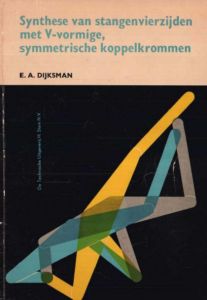In th is thesis we are concerned with the design of four-bar linkages with V-shaped, symmetrical couplercurves with a prescribed angle 2'T beiween the sides. There are two additional requirements to be satisfied:
a. One of the bars can make complete revolutions,
b. The branch of the coupler-curve which is described by the coupler-point, must be a closed curve, which does not intersect itself.
It is weIl known that the condition a is met if the four-bar linkage satisfies Grashof's inequalities. The condition b leads toan investigation of the geometrical properties of the coupler-curve with respect to its three double-points. The coupler-curve is developed as the locus of the points of intersection of two moving circles with constant radii. Indications for the existence of real double-points are found. Solutions of the main problem are given for cases where the circling-point curve does or does not degenerate. If the circling-point curve is degenerated, essentially different solutions are found in those situations where the four-bar linkage is in a cardan-position or in a generalised cycloidal position. All other positions in which the circling-point curve is degenerated are shown to be derived from these with the help of Roberts' theorem, or they can be transformed by means of reversion of the crank with respect to the fixed link into these. A separate chapter is devoted to both possibilities. The results reveal that in case of the cardan-position, not more than two different solutions can be found for each prescribed angle 2'T. Four cases can be distinguished with transitions if the length of the crank
is zero (this occurs twice) or if the coupler-point is in line with the connecting rod. The most useful solutions
are obtained in those cases where the coupler-triangle is obtuse-angled. Then the minimum transmission
angle flmin is larger than or equal to 36° for each chosen angle 2'T. The solution based on the generalised cycloidal position of the four-bar linkage is found from an equation of the ninth degree with only one real root. If in this case a value of 2'T is taken from the interval 64° ~ 2'T ~ 139°, the minimum transmission angle flmin lies in the interval 30° ~ flmtn ~ 51,45°. For other values of 2'T the minimum transmission angle is less than 30°.
For the purpose of comparison diagrams are given, each showing dimensional graphs of the four-bar linkages for the two degenerated cases. If the circling-point curve is not degenerated, an additional degree of freedom in design is obtained which opens the possibility to prescribe flmin or another quantity. Evidently it is possible to find solutions for each chosen angle 2'T with larger flmin than those obtained in the case of the cardan-position. The results have been represented by graphs in which the dimensions of the four-bar linkages are plotted as functions of 2'T. Besides, the appendix contains diagrams of four-bar linkages with optimal flmin. If the angle 2'T equals 2n devided by a positive integer, the four-bar linkage can be applied as a driving chain of an internal Geneva mechanism. Additional data of the Geneva mechanism can also been derived from graphs shown in the appendix. The ratio of times lockedjmoving of the Geneva star wheel can be variated within some limitations.
In Collection
#5524
Read It:
Yes
#5524
Read It:
Yes
|
|
||||
